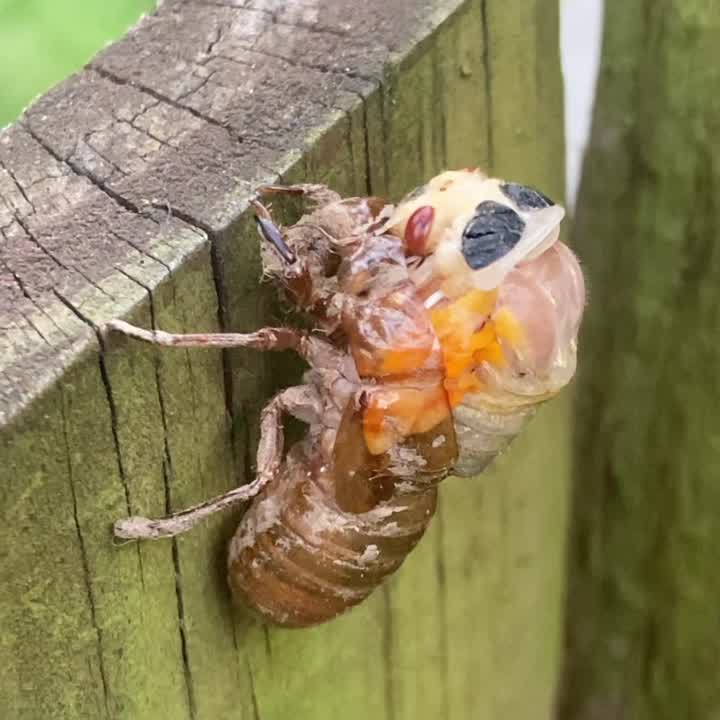How to keep cicadas out of your yard and protect your plants

Cicada molts its exoskeleton after emerging from the ground
Once off the ground, cicadas shed their skins to try and survive being eaten before moving onto the mating phase to create the next cycle of Brood X cicadas.
LOS ANGELES - Cicadas, those noisy insects emerging in swarms after years underground, can wreak havoc on gardens and landscapes.
As the cicada emergence season approaches, homeowners are gearing up to safeguard their yards from trillions of these buzzing invaders.
RELATED: 'Cicada-geddon': How close are we to the 2024 cicada explosion?
Here's a guide on how to keep cicadas out of your yard and protect your precious plants.
Understanding Cicada Behavior
Before delving into preventive measures, it's essential to understand cicada behavior. These insects emerge in 17-—or 13-year cycles, depending on the species. Once they emerge, cicadas mate and lay eggs, which can damage trees and shrubs when the nymphs hatch and burrow underground.
Installing Protective Netting or Mesh
Fine mesh or netting is a reliable barrier against adult cicadas, preventing them from accessing vulnerable plants and laying eggs.
RELATED: How loud do cicadas get?
Covering trees and shrubs with mesh can effectively shield them from cicada damage during their emergence period.
Nicholas Martin, a seasoned entomologist renowned for his expertise in pest management and the founder of the widely acclaimed blog Pest Control Hacks, suggests a practical precautionary measure: relocating or shielding outdoor furniture.
His recommendation stems from the possibility that cicada waste could find its way onto these surfaces, potentially causing inconvenience or sanitation concerns.
By proactively addressing this aspect, homeowners can maintain the cleanliness and comfort of their outdoor living spaces amidst cicada emergences.
Utilizing Row Covers for Added Protection
Row covers offer an additional layer of defense, particularly for smaller plants and vegetable gardens. These covers create a physical barrier that cicadas cannot penetrate, protecting delicate foliage from egg-laying and potential damage.
Considering Natural Predators and Pruning Practices
Encouraging natural predators like birds like robins and blue jays can help control cicada populations organically.

2016 video shows Ohio boy sweeping hundreds of cicadas off porch
In 2016, Brood V emerged from the ground after 17 years. This file video shows a boy in Mansfield, Ohio sweeping them off the family's front porch. Credit - Facebook/Richelle Smart via Storyful
Additionally, regular pruning of trees and shrubs can remove excess foliage where cicadas may lay their eggs, reducing the risk of infestation.
By implementing these proactive measures, you can effectively keep cicadas out of your yard and preserve the health and beauty of your plants throughout the emergence season.
Why are cicadas emerging?
Cicadas embark on a fascinating journey, beginning as eggs carefully laid by females in the branches of trees and shrubs. Upon hatching, the tiny nymphs drop to the soil below, where they start their subterranean odyssey.
Burrowing deep into the earth, these nymphs spend most of their lives, often 17 or 13 years,, depending on the species, feeding on the sap of tree roots and undergoing several molts as they grow and develop.
After years of patiently waiting underground, cicada nymphs sense the right conditions and embark on their grand emergence. En masse, they crawl out of the soil, climbing toward the surface with remarkable synchronicity.
Once above ground, the nymphs shed their exoskeletons, revealing their adult form. In this brief but intense phase of adulthood, male cicadas fill the air with their signature buzzing calls, a symphony designed to attract mates. Mating occurs swiftly, after which females lay their eggs in the branches of trees and shrubs, continuing the lifecycle.

